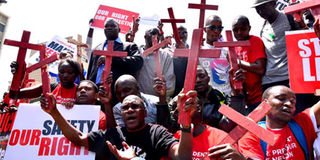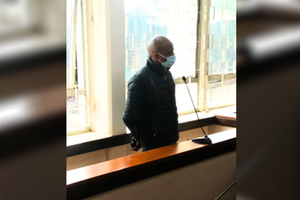Public vents anger on social media as Jubilee gaffes grow

Activists hold a peaceful protest dubbed Occupy Harrambe Avenue in Nairobi on November 25, 2014, aimed at demanding greater security from the Government following the Madera bus attack that left 28 dead. The attack by suspected Al-Shabaab militants has turned out to be a major public relations disaster for the Jubilee administration. PHOTO | SALATON NJAU |
What you need to know:
- Col David Obonyo of KDF stated that the Saturday attack by the military killed 20 Al-Shabaab fighters in Arabiya Hills along the Kenya-Somali border while a second operation targeted Godondowe where some 50 terrorists were allegedly killed.
- There were reports that he was watching the final leg of the Formula 1 race a day after the attack, something State House has not commented on.
- Major Abdullahi thinks it was “not good for the President’s image” that he remained away Dhabi after the attack.
The Mandera bus attack in which 28 Kenyans were killed by suspected Al-Shabaab militants last weekend has turned out to be a major public relations disaster for the Jubilee administration.
On Wednesday, President Uhuru Kenyatta’s response to the mounting public criticism on the security situation — which culminated in a protest on Nairobi’s Harambee Avenue last Tuesday — failed to reassure the public.
Matters were made worse after he suggested the public should bear part of the blame for the insecurity.
Over the past week, critics, mostly on social media, have questioned government’s commitment to keeping the country safe.
The President had been on a visit to the United Arab Emirates when the deadly attacked occured on November 22.
Even though the Deputy President condemned the attack on Saturday, it was not until the following day that an announcement was made that Kenyan jet fighters had bombed militant camps inside Somalia.
Mr Ruto also said the Mandera attackers were among the 100 killed.
WEAK COMMUNICATION TEAM
To dispel doubt, several images were released, mostly on social media, purportedly showing the aftermath of the KDF attacks.
But this only attracted more criticism as some of the images were said to have been either of previous attacks or manipulated.
If the response during and after the Westgate attack of September 2013 could be characterised as a stink bug, the government's response to the Mandera killings has been a skunk in so far as government’s handling of the situation is concerned, experts told Sunday Nation.
“The government failed to assuage public anger. It clearly revealed a lack of coordination between the security arms and the executive,” said the managing director of Vickers Security Bashir Abdullahi, a retired major who served with KDF.
Dr Silas Oriaso of the University of Nairobi’s School of Journalism said the response to the crisis exposed weaknesses in Jubilee’s communication team, particularly the Presidential Strategic Communications Unit (PSCU).
“Most of the communication so far has been done by people who want to shift blame,” he said, pointing out that the way the strategy to provide photographic evidence was executed also backfired.
From Saturday morning when the Mandera killings occurred until Sunday when Mr Ruto addressed the nation, official information from the government was hard to come by.
TERRORISTS PURSUED
Inspector General David Kimaiyo who addressed the press on Saturday morning, only provided a general overview of the security situation in the country and announced the extension of the Lamu curfew.
Interior Secretary Joseph ole Lenku later the same day briefly addressed the Mandera attacks while attending a function at the Nairobi Museum.
The Deputy President’s address to the nation was followed by a KDF statement that its “ground troops and helicopter gunships pursued the Al-Shabaab terrorists who conducted the heinous attack that led to the demise of 28 Kenyans.”
Col David Obonyo of KDF stated that the Saturday attack by the military killed 20 Al-Shabaab fighters in Arabiya Hills along the Kenya-Somali border while a second operation targeted Godondowe where some 50 terrorists were allegedly killed.
“Night surveillance on the area (Godondowe) showed that some of the injured had been moved on donkey carts, to a makeshift camp 10 km from Godondowe,” the KDF statement explained.
There were also reports of a third attack at a makeshift Al-Shabaab camp where 45 people were killed.
IMPROPER IMAGE
Unconvinced by the pictures and the lack of evidence to confirm the government’s assertion, attention turned to President Kenyatta who was in Abu Dhabi.
There were reports that he was watching the final leg of the Formula 1 race a day after the attack, something State House has not commented on.
Attending an event on gender activism after he returned, and with an expectant nation waiting for reassurances on security, one of the President’s seemingly trivial comments, which was promptly tweeted by his communication team, made a bad situation worse.
“I have been out of the country for a few days as you have seen from the selfies in newspapers,” he said on Wednesday. The tweet was later edited to remove the word “selfie”.
Major Abdullahi thinks it was “not good for the President’s image” that he remained away Dhabi after the attack.
“The people he left behind to handle the presidency failed to advise him properly. In other countries, the President would have cut short his visit to and take personal charge of the situation.




